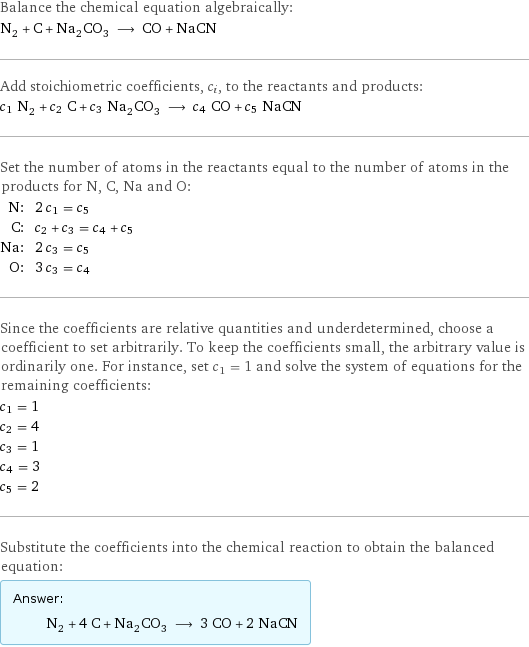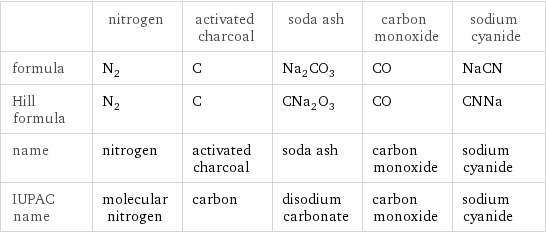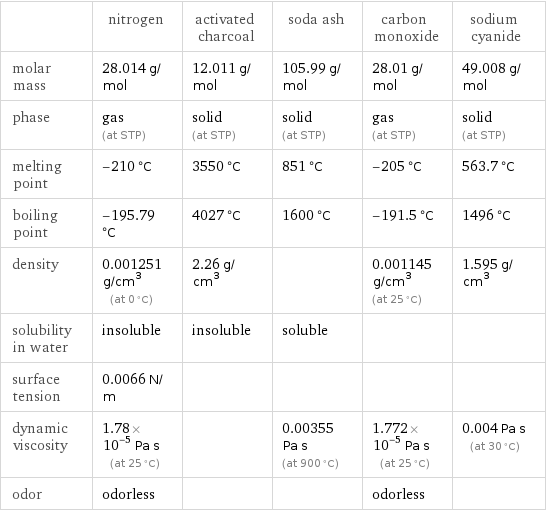Input interpretation

N_2 nitrogen + C activated charcoal + Na_2CO_3 soda ash ⟶ CO carbon monoxide + NaCN sodium cyanide
Balanced equation

Balance the chemical equation algebraically: N_2 + C + Na_2CO_3 ⟶ CO + NaCN Add stoichiometric coefficients, c_i, to the reactants and products: c_1 N_2 + c_2 C + c_3 Na_2CO_3 ⟶ c_4 CO + c_5 NaCN Set the number of atoms in the reactants equal to the number of atoms in the products for N, C, Na and O: N: | 2 c_1 = c_5 C: | c_2 + c_3 = c_4 + c_5 Na: | 2 c_3 = c_5 O: | 3 c_3 = c_4 Since the coefficients are relative quantities and underdetermined, choose a coefficient to set arbitrarily. To keep the coefficients small, the arbitrary value is ordinarily one. For instance, set c_1 = 1 and solve the system of equations for the remaining coefficients: c_1 = 1 c_2 = 4 c_3 = 1 c_4 = 3 c_5 = 2 Substitute the coefficients into the chemical reaction to obtain the balanced equation: Answer: | | N_2 + 4 C + Na_2CO_3 ⟶ 3 CO + 2 NaCN
Structures

+ + ⟶ +
Names

nitrogen + activated charcoal + soda ash ⟶ carbon monoxide + sodium cyanide
Equilibrium constant
![Construct the equilibrium constant, K, expression for: N_2 + C + Na_2CO_3 ⟶ CO + NaCN Plan: • Balance the chemical equation. • Determine the stoichiometric numbers. • Assemble the activity expression for each chemical species. • Use the activity expressions to build the equilibrium constant expression. Write the balanced chemical equation: N_2 + 4 C + Na_2CO_3 ⟶ 3 CO + 2 NaCN Assign stoichiometric numbers, ν_i, using the stoichiometric coefficients, c_i, from the balanced chemical equation in the following manner: ν_i = -c_i for reactants and ν_i = c_i for products: chemical species | c_i | ν_i N_2 | 1 | -1 C | 4 | -4 Na_2CO_3 | 1 | -1 CO | 3 | 3 NaCN | 2 | 2 Assemble the activity expressions accounting for the state of matter and ν_i: chemical species | c_i | ν_i | activity expression N_2 | 1 | -1 | ([N2])^(-1) C | 4 | -4 | ([C])^(-4) Na_2CO_3 | 1 | -1 | ([Na2CO3])^(-1) CO | 3 | 3 | ([CO])^3 NaCN | 2 | 2 | ([NaCN])^2 The equilibrium constant symbol in the concentration basis is: K_c Mulitply the activity expressions to arrive at the K_c expression: Answer: | | K_c = ([N2])^(-1) ([C])^(-4) ([Na2CO3])^(-1) ([CO])^3 ([NaCN])^2 = (([CO])^3 ([NaCN])^2)/([N2] ([C])^4 [Na2CO3])](../image_source/47c0541bc6dc08a8ecb75dafe185ff5e.png)
Construct the equilibrium constant, K, expression for: N_2 + C + Na_2CO_3 ⟶ CO + NaCN Plan: • Balance the chemical equation. • Determine the stoichiometric numbers. • Assemble the activity expression for each chemical species. • Use the activity expressions to build the equilibrium constant expression. Write the balanced chemical equation: N_2 + 4 C + Na_2CO_3 ⟶ 3 CO + 2 NaCN Assign stoichiometric numbers, ν_i, using the stoichiometric coefficients, c_i, from the balanced chemical equation in the following manner: ν_i = -c_i for reactants and ν_i = c_i for products: chemical species | c_i | ν_i N_2 | 1 | -1 C | 4 | -4 Na_2CO_3 | 1 | -1 CO | 3 | 3 NaCN | 2 | 2 Assemble the activity expressions accounting for the state of matter and ν_i: chemical species | c_i | ν_i | activity expression N_2 | 1 | -1 | ([N2])^(-1) C | 4 | -4 | ([C])^(-4) Na_2CO_3 | 1 | -1 | ([Na2CO3])^(-1) CO | 3 | 3 | ([CO])^3 NaCN | 2 | 2 | ([NaCN])^2 The equilibrium constant symbol in the concentration basis is: K_c Mulitply the activity expressions to arrive at the K_c expression: Answer: | | K_c = ([N2])^(-1) ([C])^(-4) ([Na2CO3])^(-1) ([CO])^3 ([NaCN])^2 = (([CO])^3 ([NaCN])^2)/([N2] ([C])^4 [Na2CO3])
Rate of reaction
![Construct the rate of reaction expression for: N_2 + C + Na_2CO_3 ⟶ CO + NaCN Plan: • Balance the chemical equation. • Determine the stoichiometric numbers. • Assemble the rate term for each chemical species. • Write the rate of reaction expression. Write the balanced chemical equation: N_2 + 4 C + Na_2CO_3 ⟶ 3 CO + 2 NaCN Assign stoichiometric numbers, ν_i, using the stoichiometric coefficients, c_i, from the balanced chemical equation in the following manner: ν_i = -c_i for reactants and ν_i = c_i for products: chemical species | c_i | ν_i N_2 | 1 | -1 C | 4 | -4 Na_2CO_3 | 1 | -1 CO | 3 | 3 NaCN | 2 | 2 The rate term for each chemical species, B_i, is 1/ν_i(Δ[B_i])/(Δt) where [B_i] is the amount concentration and t is time: chemical species | c_i | ν_i | rate term N_2 | 1 | -1 | -(Δ[N2])/(Δt) C | 4 | -4 | -1/4 (Δ[C])/(Δt) Na_2CO_3 | 1 | -1 | -(Δ[Na2CO3])/(Δt) CO | 3 | 3 | 1/3 (Δ[CO])/(Δt) NaCN | 2 | 2 | 1/2 (Δ[NaCN])/(Δt) (for infinitesimal rate of change, replace Δ with d) Set the rate terms equal to each other to arrive at the rate expression: Answer: | | rate = -(Δ[N2])/(Δt) = -1/4 (Δ[C])/(Δt) = -(Δ[Na2CO3])/(Δt) = 1/3 (Δ[CO])/(Δt) = 1/2 (Δ[NaCN])/(Δt) (assuming constant volume and no accumulation of intermediates or side products)](../image_source/49d6dbfccf21d8aad8d62050735148d8.png)
Construct the rate of reaction expression for: N_2 + C + Na_2CO_3 ⟶ CO + NaCN Plan: • Balance the chemical equation. • Determine the stoichiometric numbers. • Assemble the rate term for each chemical species. • Write the rate of reaction expression. Write the balanced chemical equation: N_2 + 4 C + Na_2CO_3 ⟶ 3 CO + 2 NaCN Assign stoichiometric numbers, ν_i, using the stoichiometric coefficients, c_i, from the balanced chemical equation in the following manner: ν_i = -c_i for reactants and ν_i = c_i for products: chemical species | c_i | ν_i N_2 | 1 | -1 C | 4 | -4 Na_2CO_3 | 1 | -1 CO | 3 | 3 NaCN | 2 | 2 The rate term for each chemical species, B_i, is 1/ν_i(Δ[B_i])/(Δt) where [B_i] is the amount concentration and t is time: chemical species | c_i | ν_i | rate term N_2 | 1 | -1 | -(Δ[N2])/(Δt) C | 4 | -4 | -1/4 (Δ[C])/(Δt) Na_2CO_3 | 1 | -1 | -(Δ[Na2CO3])/(Δt) CO | 3 | 3 | 1/3 (Δ[CO])/(Δt) NaCN | 2 | 2 | 1/2 (Δ[NaCN])/(Δt) (for infinitesimal rate of change, replace Δ with d) Set the rate terms equal to each other to arrive at the rate expression: Answer: | | rate = -(Δ[N2])/(Δt) = -1/4 (Δ[C])/(Δt) = -(Δ[Na2CO3])/(Δt) = 1/3 (Δ[CO])/(Δt) = 1/2 (Δ[NaCN])/(Δt) (assuming constant volume and no accumulation of intermediates or side products)
Chemical names and formulas

| nitrogen | activated charcoal | soda ash | carbon monoxide | sodium cyanide formula | N_2 | C | Na_2CO_3 | CO | NaCN Hill formula | N_2 | C | CNa_2O_3 | CO | CNNa name | nitrogen | activated charcoal | soda ash | carbon monoxide | sodium cyanide IUPAC name | molecular nitrogen | carbon | disodium carbonate | carbon monoxide | sodium cyanide
Substance properties

| nitrogen | activated charcoal | soda ash | carbon monoxide | sodium cyanide molar mass | 28.014 g/mol | 12.011 g/mol | 105.99 g/mol | 28.01 g/mol | 49.008 g/mol phase | gas (at STP) | solid (at STP) | solid (at STP) | gas (at STP) | solid (at STP) melting point | -210 °C | 3550 °C | 851 °C | -205 °C | 563.7 °C boiling point | -195.79 °C | 4027 °C | 1600 °C | -191.5 °C | 1496 °C density | 0.001251 g/cm^3 (at 0 °C) | 2.26 g/cm^3 | | 0.001145 g/cm^3 (at 25 °C) | 1.595 g/cm^3 solubility in water | insoluble | insoluble | soluble | | surface tension | 0.0066 N/m | | | | dynamic viscosity | 1.78×10^-5 Pa s (at 25 °C) | | 0.00355 Pa s (at 900 °C) | 1.772×10^-5 Pa s (at 25 °C) | 0.004 Pa s (at 30 °C) odor | odorless | | | odorless |
Units
